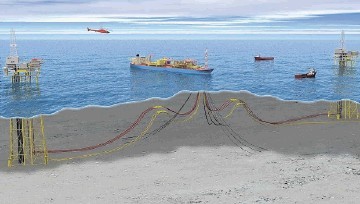
Norway’s Statoil has completed its first multi-lateral well offshore Brazil as part of its increased oil recovery (IOR) campaign in the Peregrino field located on Campos Basin block BM-C-7.
This is the first multi-lateral well in Brazil with gravel pack in both branches, a practice that draws on the company’s successes on the Norwegian Continental Shelf where the average recovery factor for oil stands around 46% compared with 42% for the UK Continental Shelf.
The well was drilled using the semi-submersible drilling rig Blackford Dolphin, itself a veteran on the North Sea.
Statoil is regarded as the number-one player in the use of multi-lateral junction technology and has by far the largest share of the total global use offshore.
Over the last few years, it has introduced multi-lateral well technology at several of the company’s operated fields offshore Norway.
“Brazil is a country where we can apply our offshore technology,” said in-country president Kjetil Hove.
“We have always cited that our technology and experience from the NCS would be key to increasing Peregrino’s recovery rate. Today we are proud to announce that we have passed yet another significant milestone as an operator in Brazil by proving our ability to utilise our technological competence.”
Statoil intends to raise its recovery factor in Brazil even further. Peregrino is an offshore heavy oil field and offers considerable potential increased recovery. The average density of its viscous crude is 13deg API.
It holds large in-place volumes of about 2.3billion bbl of oil in addition to resources discovered at Peregrino South. However, the recovery factor is low compared to conventional oilfields. This is generally the case for heavy crude reservoirs.
However, by applying innovative technology Statoil has doubled the expected recovery factor from around 10% when it bought into the field to around 20% expected recovery when Peregrino was sanctioned.
According to the company, the keys to increased recovery for this field are a high degree of reservoir exposure, the drilling of long horizontal wells with geosteering technology to maximise length and optimise placement, and water injection to improve oil recovery.
By applying tools and skills such as produced water injection, horizontal wells, and flow assurance to sustain the project over a longer term, the estimated recoverable resources have been increased to 300-600million barrels of oil.
Thus far, 15 production wells have been drilled at Peregrino, all of them using advanced horizontal well technology to maximise recovery.
The field’s phase one infrastructure comprises two drilling and wellhead platforms and a large floating production, storage, and offloading vessel.
Peregrino is currently one of Brazil’s largest producing offshore oilfields. It is located 85km offshore in about 100m of water on licences BM-C-7 and BM-C-47.
The field was discovered in 2004 and is operated by Statoil with 60% interest in partnership with Sinochem holding the remaining 40% and is far from being the only heavy crude resource in the Campos.
Phase one production started in April last year, with production expected to reach 120,000 barrels per day this year.
The field will be completed in three phases and will include approximately 60 wells; phase one of the project includes 37 wells; 30 production wells and seven water injectors.
The temperature of the oil, gas, water and sand uplifted from the field is 79.6°C in the reservoir and 60-66°C on arrival in the ship, and then heated to 130-150°C for processing (separation). After this, the temperature is kept at 65-70°C to prevent the crude from solidifying.